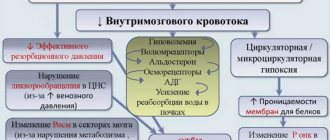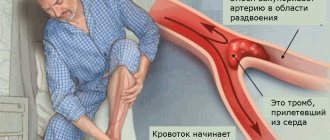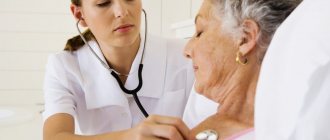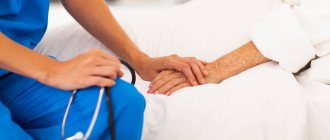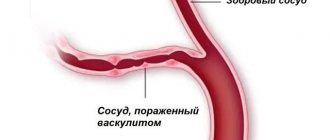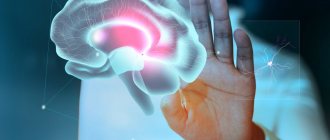28.06.2019
Stroke is an acute disorder of cerebral circulation due to blockage of blood vessels or their rupture. After a vascular accident, neurological symptoms develop within a few minutes or hours, which progress, sometimes leading to death. Recently, cases of stroke have become more frequent at young ages, up to 30 years.
Kinds
The main classification of strokes (according to ICD-10) takes into account the cause and mechanism of stroke.
- An ischemic stroke is characterized by a cessation of blood flow to the brain tissue. The reason is a violation of blood flow, blockage of an artery with a blood clot and/or narrowing by an atherosclerotic plaque (atherothrombotic), vasospasm, and a decrease in pressure. Most often develops at the age of 50-69 years. The incidence is 64-75% among all types of stroke.
- Hemorrhagic stroke is a hemorrhage into the substance of the brain or under the arachnoid membrane due to rupture of a vessel as a result of high blood pressure, atherosclerosis, vasculitis, aneurysms, coagulation disorders. Patients aged 50-69 years are at high risk. At 39-49 years old it is less common. The incidence is 15-20% among all types of stroke.
There are classifications that distinguish types of stroke taking into account other signs.
1. By severity:
- minor, including microstroke (transient ischemic attack) - a passing disturbance of cerebral circulation with complete disappearance of neurological symptoms within 1 day to 3 weeks;
- moderate severity;
- severe, extensive stroke of the brain - damage to a large area with pronounced neurological symptoms and severe condition, sometimes with falling into a deep coma.
2. By location
- left or right hemisphere. Each side is responsible for different functions, so the symptoms will be different. For example, if the left half is affected, the movements of the right side of the body suffer, speech and memory are impaired. The person loses the ability to read and write.
When the right hemisphere is damaged, the movement of the left side of the body, the perception of oneself, one’s body, and the surrounding space are impaired, and mental disorders develop.
3. By quantity
- primary stroke (first) and repeated strokes (second, third, fourth). Repeated strokes are more severe because the lesion area increases each time.
4. By age
- in children, starting from the prenatal period, young, elderly. The severity of clinical manifestations and prognosis depend on the patient’s age, the cause of concomitant pathology, and the timeliness of diagnosis. The most difficult prognosis is for delayed detection of a stroke, a large lesion, a weakened body due to concomitant diseases, bad habits, and vitamin deficiency.
5. By localization
:
- in the vertebrobasilar basin with damage to the occipital lobe of the brain, cerebellum and brainstem - visual disturbances develop, gait changes;
- frontal lobes - speech and swallowing suffer;
- temporal lobes - memory, writing, speech deteriorate;
- parietal lobe - speech and speech understanding suffer.
Development and risk groups
The development of a stroke is caused by a sharp increase in blood pressure, physical activity, and emotional stress. In such situations, a vessel ruptures followed by hemorrhage or spasm with ischemia. Predisposing factors are diabetes mellitus, high cholesterol, heart, vascular and blood diseases, and excess weight. In these diseases, blood vessels lose their elasticity and their walls stretch. People who or their close relatives have had a stroke or heart attack should be especially careful.
There are scales that determine the degree of risk of developing a stroke: the Framingham scale for assessing individual risk of developing stroke, the London School of Hygiene questionnaire on cardiovascular diseases by J. Rose.
By undergoing such testing, you can identify the degree of risk, undergo an examination and undergo a course of treatment in a timely manner before your health is affected.
Risk groups are identified:
- by age and gender - the likelihood of a stroke increases after 30 years. Ischemic stroke occurs more often in men aged 50-69 years. The incidence of hemorrhagic stroke up to 60 years of age is the same in men and women, then higher in women;
- in terms of lifestyle - unfavorable factors include inactivity, bad habits, stress, heavy physical labor. These factors worsen health and provoke chronic heart and vascular diseases.
First signs and symptoms
Before a stroke, drowsiness, headache, numbness of the limbs, fatigue, spots before the eyes, nausea, dizziness, temperature fluctuations, and blood pressure jumps appear. These are the harbingers or first signs of a stroke that appear several hours or days before the disaster. Most often, these symptoms are ignored, or they are attributed to fatigue and overwork.
Symptoms of a stroke themselves are divided into general cerebral and focal. They can be of varying degrees of severity depending on the prevalence of the pathological process.
- General cerebral symptoms: headache, impaired consciousness up to loss of consciousness, stupor, agitation or weakness, disorientation in space and time, sweating, feeling hot, convulsions. Makes you feel sleepy and sometimes chills.
- The focal abnormalities of a stroke depend on which area of the brain is affected. They can be unilateral or bilateral. This group includes disturbances in speech, vision (visual hallucinations), gait, movements up to paralysis, and sensitivity.
Symptoms of ischemic cerebral stroke develop gradually, with focal symptoms predominant.
With a hemorrhagic stroke, the onset is rapid, with a predominance of cerebral symptoms.
There are several stages in the development of a stroke: the acute period (from the moment of the stroke to 3 weeks on average), the recovery period - from 2 weeks to 24 months.
What to do if you have a stroke
There are techniques that allow you to identify signs of a stroke yourself. For example, they can be used if someone becomes ill on the street and you suspect a stroke. You need to ask the person to smile, speak, raise both hands. If the victim cannot comply with your request or there is asymmetry, you should immediately call for help and list all the symptoms.
At the same time, you need to provide first aid: lay the victim down, placing a small support under his head, and free him from clothes that are preventing him from breathing. He should not eat or drink or make sudden movements. When vomiting, turn your head to the side.
Further treatment is carried out in a hospital. First, diagnostics are carried out to clarify the diagnosis; computed tomography and magnetic resonance imaging, lumbar puncture and EEG (echoencephalography), angiography are prescribed. Then conservative (basic therapy, treatment of neurological complications) or surgical treatment is prescribed.
After the end of the acute period, rehabilitation is prescribed: massage, physical therapy and other activities, depending on the degree and type of disorder. The patient is observed by a neurologist, physiotherapist, speech therapist, and psychotherapist.
The brain has neuroplasticity: with the right approach, you can recover from a stroke, restore brain function and prevent stroke complications. The key factor is timely initiation of treatment, proper rehabilitation and regular exercise.
According to WHO, about 60% of patients do not require assistance by the end of the first year, and 30% of patients of working age can return to work.
Some general recommendations
You can increase your chances of life only by observing a few general conditions.
- If the patient’s relatives, after an attack of a major stroke, provide him with the necessary pre-medical care and take all measures for the fastest delivery to the hospital.
- The medical institution has the necessary diagnostic and therapeutic equipment to ensure an accurate diagnosis and effective treatment. It is desirable to be able, if necessary, to immediately perform craniotomy to remove hematoma or cerebral edema.
- Having returned to consciousness, the patient makes enough moral and physical efforts to fight for life.
After carrying out a set of emergency medical measures to maintain the vital functions of the body during a coma, the final result largely depends not on the doctors, but on the body itself. This refers not only to the general physical condition, but also to psychological factors that have not been studied by official medical science and operate at the subconscious level. Relatives should constantly talk to the patient, instill optimism in him, and support him. Let the doctors say that he can’t hear, don’t pay attention to it. No one can say with complete certainty how the brain in a coma reacts to the speech of the closest people.
As soon as consciousness returns to the patient, it is recommended not only to talk to him, but also to try to do simple gymnastic exercises. Everyone knows about the benefits of massage performed by a trained specialist. But no one can explain why simply stroking the hand of a loved one has a huge healing effect. Over time, it is advisable for relatives to learn proper massage care; this can significantly improve the results of treatment and significantly speed up the rehabilitation process.
The patient should not feel like a burden to relatives; such a condition can completely eliminate the influence of the body’s internal forces on the course of the disease. As a result, deaths increase significantly. A sick person should always know that he is loved in any condition, that all relatives are making every effort to restore health.
Video - Hemorrhagic stroke
Prevention
- Primary prevention consists of proper nutrition, exercise, giving up bad habits and stress, adequate sleep and rest, and regular medical examinations.
- Secondary prevention of stroke includes the elimination of risk factors - treatment of concomitant pathologies, regular monitoring by the attending physician, elimination of risk factors. This approach will help not only prevent stroke, but also improve overall health. According to WHO estimates, the creation of an adequate system of care for patients with stroke will make it possible in the coming years to reduce mortality during the 1st month of the disease by 20% and ensure independence in everyday life 3 months after its onset in at least 70% of patients.
How can you increase your chances?
Each person is individual and their body copes with illness differently. Some stop walking and working, while others simply become less active. Anyone can recover, the main thing is to follow the doctor’s recommendations and listen to your body.
The sooner you start rehabilitation, the faster your brain will recover. In the beginning, gymnastics and massage will help. The rehabilitation program includes exercise therapy and classes on robotic simulators.
Important! Stroke also affects the psyche. Often, the help of a psychiatrist is required.
FAQ
How is a stroke different from a heart attack?
Cerebral infarction is one of the types of stroke and it is ischemic in nature, i.e. accompanied by a cessation of blood flow to the brain. A characteristic feature is the gradual development of the clinical picture and the predominance of focal symptoms: disturbances in speech, vision, gait, movements up to paralysis, sensitivity.
Can a stroke and heart attack happen at the same time?
If we consider only the brain, mixed stroke occurs, when the causes of stroke include both hemorrhage and ischemia. They can occur simultaneously when a vessel ruptures in one area and blood flow stops in another. Also, ischemia can develop at the site of subarachnoid hemorrhage after some time.
If we consider a heart attack as a heart disease, then these conditions can also be diagnosed simultaneously. Moreover, a stroke can develop as a result of a heart attack: the functioning of the heart suffers, and insufficient blood flows to the brain. This is how we get a stroke.
Does a stroke only occur in the brain?
Stroke (Latin insultus “swoop, attack, blow”) is an acute disruption of the blood supply to the brain due to ischemia (infarction) or hemorrhage. If ischemia occurs in other organs, it is also called a heart attack. For example, myocardial infarction, intestinal, kidney, etc. It is characterized by severe pain, dysfunction of the affected organ and other symptoms.
Does stroke occur with normal or low blood pressure?
Arterial hypertension is one of the main, but not the only causes of stroke. Thrombosis, atherosclerosis, and diabetes mellitus, in which blood pressure is normal or even reduced, are also risk factors. In addition, with low pressure, the brain is not sufficiently supplied with oxygen, which is a prerequisite for the development of ischemic stroke.
Do children have strokes?
Stroke is also diagnosed in children. It can develop even in the perinatal period. Causes: abnormalities in the coagulation system, pathologies of the cardiovascular system, including vascular malformations, bad habits of the mother during pregnancy, oxygen starvation during childbirth, trauma.
In the perinatal period and up to one year, the disease is accompanied by anxiety, frequent crying, loss of appetite, impaired reflexes in the newborn period, strabismus, and convulsions. The diagnosis is made based on an examination by a pediatric neurologist, ultrasound of the brain, and tomography results. At older ages, symptoms are similar to those of stroke in adults.
The child's body is more flexible and responds more quickly to therapy. The main thing is to diagnose a stroke in time and begin treatment.
Can a stroke go away on its own?
There is such a condition - transient stroke. It is accompanied by a short-term circulatory disorder, but no irreversible changes in brain tissue occur. The external manifestations of such a stroke are the same as a normal one, but less pronounced: headache, dizziness, darkening of the eyes, changes in sensitivity in various parts of the body. And they pass within 24 hours. However, the condition requires qualified treatment and rehabilitation, elimination of risk factors, because in the future there is a possibility of a secondary stroke.
At what pressure can a stroke occur?
A stroke can develop at any pressure. Arterial hypertension causes hemorrhagic stroke, hypotension causes ischemic stroke.
Do pine cones help prevent stroke?
Pine cones lower blood pressure, so they should not be consumed if you have hypotension. The effect is due to the tannins contained in the buds. The composition also contains vitamins C and P - they strengthen the walls of blood vessels and improve blood circulation.
The advisability of using products based on herbal raw materials is decided by the attending physician after a detailed examination. In general, pine cones for stroke can only be used as a complementary method.
Treatment
Stroke therapy in the acute period may include:
- Pain relief, correction of body temperature (paracetamol, efferalgan, naproxen, diclofenac, often opiates, propafol). Aspizol, dantrolene are given intravenously, and magnesium sulfate is given by drip.
- Reducing blood pressure, which helps stop bleeding in the brain. For this purpose, drugs are administered intravenously: labetalol, nicardipine, esmolol, hydralazine. However, a sharp decrease in pressure in the first days is not allowed. Next, tablet drugs are prescribed - captopril, enalapril, capoten (as basic therapy orally or through a tube).
- Diuretics for persistent high blood pressure (chlorothiazide, andapamide, Lasix), calcium antagonists (nimotop, nifedipine).
- In case of severe hypotension, vasopressors are prescribed by drip (norepinephrine, mesaton, dopamine).
- Often, a continuous intravenous infusion is used to administer the above drugs, monitoring the pressure level every 15 minutes.
- To reduce cerebral edema, dexamethasone is recommended for 3 days (intravenously). If the swelling progresses, glycerin, mannitol, albumin, and refortan are injected dripwise.
- Often, a continuous intravenous infusion is used to administer the above drugs, monitoring the pressure level every 15 minutes.
- Drugs for the correction of neurological symptoms (sedatives - diazepam, muscle relaxants - vecuronium).
- Local therapy is aimed at eliminating bedsores and includes treating the skin with camphor alcohol and sprinkling with talcum powder.
- Symptomatic therapy - anticonvulsants (lorazepam, thiopental or anesthesia for 1-2 hours), medications for vomiting and nausea (metoclopramide, torecan), against psychomotor agitation (haloperidol). For pneumonia and urological infections, a course of antibacterial treatment is carried out.
In the presence of large hematomas (more than 50 ml), surgical intervention is performed. Excision of the hemorrhage site can be carried out if it is localized in an accessible part of the brain, and also if the patient is not in a comatose state. Most often, clipping of the aneurysm neck, puncture-aspiration elimination of the hematoma, its direct removal, as well as ventricular drainage are used.
